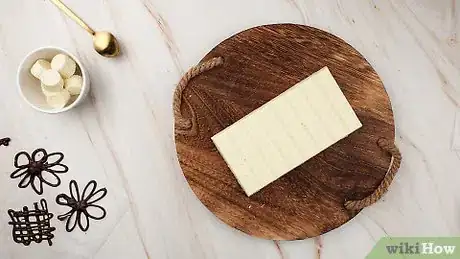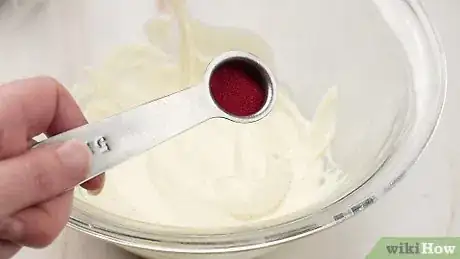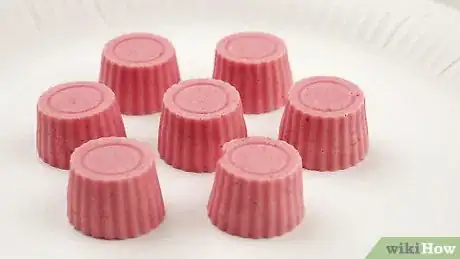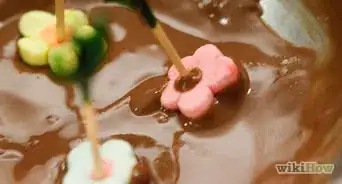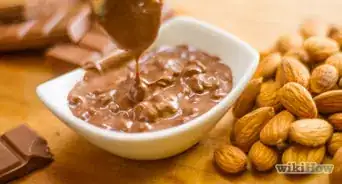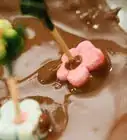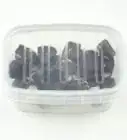This article was co-authored by Mathew Rice. Mathew Rice has worked in restaurant pastry kitchens across the country since the late 1990's, and currently owns Pink Door Cookies in Nashville. His creations have been featured in Food & Wine, Bon Appetit, and Martha Stewart Weddings. In 2016, Eater named Mathew one of the top 18 chefs to follow on Instagram. In 2018, he appeared in season 18 of the Food Network's Beat Bobby Flay and won his episode.
There are 8 references cited in this article, which can be found at the bottom of the page.
wikiHow marks an article as reader-approved once it receives enough positive feedback. In this case, 100% of readers who voted found the article helpful, earning it our reader-approved status.
This article has been viewed 453,857 times.
To color chocolate, you'll need to melt it first. This is always a tricky process, and even more difficult with white chocolate, which burns easily. If possible, allow extra time to track down the right ingredients and work on a test batch.
Steps
Expert Q&A
Did you know you can get premium answers for this article?
Unlock premium answers by supporting wikiHow
-
QuestionWhat is the best way to melt white chocolate?
 Mathew RiceMathew Rice has worked in restaurant pastry kitchens across the country since the late 1990's, and currently owns Pink Door Cookies in Nashville. His creations have been featured in Food & Wine, Bon Appetit, and Martha Stewart Weddings. In 2016, Eater named Mathew one of the top 18 chefs to follow on Instagram. In 2018, he appeared in season 18 of the Food Network's Beat Bobby Flay and won his episode.
Mathew RiceMathew Rice has worked in restaurant pastry kitchens across the country since the late 1990's, and currently owns Pink Door Cookies in Nashville. His creations have been featured in Food & Wine, Bon Appetit, and Martha Stewart Weddings. In 2016, Eater named Mathew one of the top 18 chefs to follow on Instagram. In 2018, he appeared in season 18 of the Food Network's Beat Bobby Flay and won his episode.
Professional Baker & Dessert Influencer I prefer to melt my chocolate in a double boiler. I'll bring my water to a boil, then turn off the stove and sit my chocolate in another pot over the water to let it melt. It's going to take a little bit longer, but the nice consistency is worth the wait. If I'm in a rush, I might use the microwave and melt it down with the microwave set to about half-power, stopping and stirring every 15 seconds.
I prefer to melt my chocolate in a double boiler. I'll bring my water to a boil, then turn off the stove and sit my chocolate in another pot over the water to let it melt. It's going to take a little bit longer, but the nice consistency is worth the wait. If I'm in a rush, I might use the microwave and melt it down with the microwave set to about half-power, stopping and stirring every 15 seconds. -
QuestionWhat is caramelized white chocolate?
 wikiHow Staff EditorThis answer was written by one of our trained team of researchers who validated it for accuracy and comprehensiveness.
wikiHow Staff EditorThis answer was written by one of our trained team of researchers who validated it for accuracy and comprehensiveness.
Staff Answer wikiHow Staff EditorStaff Answer
wikiHow Staff EditorStaff Answer -
QuestionCould I use gel colouring for white chocolate?
 Community AnswerYes, you can use white chocolate for this.
Community AnswerYes, you can use white chocolate for this.
Things You'll Need
- Double boiler (bain marie)
- Rubber or silicone spatula or stirrer
- Food coloring — powdered or oil-based strongly recommended
- Bowl & zip-locked bag (if using oil-based food coloring)
- Additional white chocolate for tempering (optional)
Warnings
- Melting chocolate is very difficult if humidity levels are above 50%. Run a dehumidifier in clammy weather.⧼thumbs_response⧽
References
- ↑ http://www.craftsy.com/blog/2013/10/types-of-food-coloring/
- ↑ https://books.google.com/books?id=tWX5AAAAQBAJ
- ↑ https://www.craftybaking.com/learn/ingredients/chocolate/tools
- ↑ http://www.fabulousfoods.com/articles/19935/all-about-chocolate-buying-storing-melting-tempering-and-using
- ↑ http://www.fabulousfoods.com/articles/19935/all-about-chocolate-buying-storing-melting-tempering-and-using
- ↑ https://www.craftybaking.com/learn/ingredients/chocolate/tools
- ↑ http://www.ecolechocolat.com/en/chocolate-tempering.html
- ↑ http://www.fabulousfoods.com/articles/19935/all-about-chocolate-buying-storing-melting-tempering-and-using
- ↑ http://www.seriouseats.com/2014/12/the-food-lab-best-way-to-temper-chocolate.html
About This Article
To color white chocolate, start by warming the chocolate slowly over a double boiler so that it doesn’t burn. If you are using a liquid food dye, add a few drops to the chocolate before it starts to melt so that it doesn’t cause the chocolate to seize up and thicken. Alternatively, if you are using powder or oil-based food dye, add it after the chocolate starts to melt. Then, stir the food coloring into the chocolate until it’s blended and smooth. For tips on how to temper white chocolate after you’ve colored it so it hardens shiny and firm, read on!
